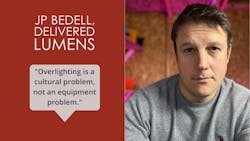LAST WORD | The real reason we’re losing our night skies
Lighting designers don’t want to be the “killers” of the night sky. For the most part, they have championed dark-sky regulations. Outdoor lighting manufacturers have also developed “dark-sky friendly” luminaires. Unfortunately, this alone will not save the night sky. Without truly embracing darkness, we will lose the stars in favor of a false sense of safety and the will of commerce.
In specification lighting, we’ve focused on eliminating uplight. While this might help reduce unwanted sky glow, it’s not the main contributor to our loss of the night sky. The primary cause of light pollution is simple: We overlight our nighttime environments. There are many reasons, but chief among them is that we are lighting outdoor spaces for cars and not for people.
We have all seen parking lots illuminated through the night — regardless of activity level — to absurd light levels in the name of safety. The selected LED luminaires may be dark-sky compliant, but concrete is reflective, so in the aggregate, thousands of parking lots bounce enough light into the atmosphere to create unwanted sky glow.
But the problem does not stop at parking lots. We are still lighting roadways as if it were 1955 and cars were equipped with tiny halogen headlights. If you have ever been on an airplane flying west to east over the United States, it’s easy to see the accumulated sky glow as you approach the New York metro area. This is not due to uplighting but rather to an obsession with brightness at night.
Irresponsible lighting designers are not the root cause of this battle for darkness. We are losing the night sky because we are quite literally afraid of the dark and don’t know how to deal with it. Without direct re-education of both the public and the engineers responsible for municipal lighting, we will not see improvement.
While I don’t believe we can convince most people to simply turn off the lights, over time we can gradually introduce measures aimed at reducing sky glow. Chief among these is lighting controls systems. We need to deploy more aggressive lighting control measures to take advantage of LED’s inherent dimmability, thereby reducing harm to wildlife and embracing the night sky again.
Widespread adoption of time clock controls that will dim or turn off lighting at night would instantly reduce light pollution in locations where illumination is not required all night long. In suburban environments, streetlighting could be deactivated after midnight to allow for true darkness, or it could dim slowly from sunset to an appointed time. In urban environments, streetlights could be reduced in intensity — except for near crosswalks to permit safe street crossing. Occupancy sensors and camera-based controls could reduce the time lights are on in unoccupied areas while promoting safety as people move through spaces such as bike paths or pedestrian walkways that are lightly traveled at night.
Roadway billboards represent an additional light pollution source, and full-time operation wastes energy. Instead of operating billboards throughout the night regardless of activity, LED signage for advertising should be restricted to certain zones where commerce is expected —for example, in Times Square or on the Las Vegas Strip.
Of course, the lighting community must educate the public on the need for beneficial darkness in order for these measures to be accepted and adopted. Thankfully, such education is underway, but it needs to increase and establish the value of darkness for enhancing sleep, preserving wildlife, and observing the stars at night.
We can achieve these goals if we stop pretending that a certain kind of luminaire will eradicate light pollution. Overlighting is a cultural problem, not an equipment problem. Once the culture shifts, lighting professionals can focus on creating elegant, people-friendly nighttime environments that don’t ruin the night sky.
In addition to representing Stan Deutsch Associates and liaising with specifiers in the greater New York Metro area, JP BEDELL shares his passion for high-quality, sustainable, and accessible lighting by mentoring young designers, interviewing inspiring professionals for his “Delivered Lumens” podcast series, writing about industry trends and issues, and speaking at conferences and events.
Follow our LinkedIn page for our latest news updates, contributed articles, and commentary, and our Facebook page for events announcements and more. You can also find us on the X platform.

JP Bedell
JP BEDELL began his lighting design career in the theater community while attending Pace University. His decades of experience include architectural lighting in commercial, hospitality, retail, and high-end residential applications as well. In addition to representing Stan Deutsch Associates and liaising with specifiers in the greater New York Metro area, Bedell shares his passion for high-quality, sustainable, and accessible lighting by mentoring young designers, interviewing inspiring professionals for his “Delivered Lumens” podcast series, writing about industry trends and issues, and speaking at conferences and events.





